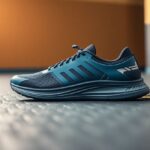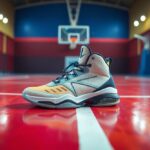
Explore the groundbreaking advancements in running footwear technology that have dramatically transformed the performance standards for endurance athletes, offering exciting new opportunities for improvement.
The enhancement of performance in endurance running has significantly evolved due to the influence of advanced footwear technology. This pioneering innovation provides athletes with remarkable chances to reach their peak potential. You will discover how cutting-edge shoe designs can greatly reduce your metabolic expenditure and improve your running economy. By integrating carbon fibre plates and revolutionary midsole materials, these shoes are conceived to provide remarkable energy return mechanisms that could lower your oxygen consumption by as much as 4%. Whether you are an experienced professional or an eager beginner, understanding these biomechanical advancements can empower you to make informed decisions regarding your running gear and potentially improve your race times.
 Continue reading to gain deeper insights into the mechanics of running footwear designed to enhance your performance:
Continue reading to gain deeper insights into the mechanics of running footwear designed to enhance your performance:
Understanding Energy Return Mechanisms in Cutting-Edge Running Footwear
The most recent advancements in running shoe technology harness intricate biomechanical principles to optimise energy transfer throughout the running motion. Innovative design features work cohesively to lessen metabolic expenditure, resulting in a sophisticated system that enhances running efficiency through strategic material engineering and geometric configurations. By focusing on the mechanics of energy return, these shoes provide runners with a distinct advantage in both performance and stamina, enabling longer runs with reduced fatigue levels.
Examining the Curvature Dynamics of Carbon Fibre Plates
Carbon fibre plates employ precise geometric engineering to redirect kinetic energy throughout the running cycle. Optimal curvature angles between 12°-15° facilitate maximum energy storage and return, with finite element modelling showing energy return efficiencies reaching up to 93% in prototype designs. These carefully engineered plates create a spring-like mechanism that diminishes muscular exertion during toe-off phases, allowing runners to conserve energy over greater distances, thus promoting endurance and overall performance.
Comparing TPU and EVA in Midsole Technology Innovations
Material selection plays a crucial role in determining shoe performance, with thermoplastic polyurethane (TPU) emerging as a dominant midsole technology. Comparative analyses highlight TPU’s substantial advantages in energy return and impact absorption, providing runners with enhanced biomechanical efficiency across various running conditions. The choice between TPU and EVA foam is critical for athletes aiming to improve their performance while minimising the potential for injuries during both training and competition.
| Energy Return | 18% higher in TPU |
| Oxygen Consumption Reduction | 2.4% lower with TPU |
A comprehensive examination of midsole materials reveals nuanced performance characteristics. TPU exhibits superior resilience in comparison to traditional EVA foam, maintaining consistent mechanical properties across thousands of compression cycles. Runners benefit from more dependable energy return, lower fatigue levels, and enhanced long-distance performance through advancements in material science, which can significantly affect their overall training results and competitive outcomes.
| Impact Absorption | TPU absorbs 37% more force |
| Rebound Elasticity | 89% maintained across 50,000 cycles |
 Continue as we explore the impact of advanced footwear technology on metabolic efficiency:
Continue as we explore the impact of advanced footwear technology on metabolic efficiency:
Assessing Metabolic Efficiency: Understanding Who Benefits Most from Advanced Footwear
The benefits of advanced footwear technology are not uniformly distributed among all runners. Improvements in metabolic efficiency exhibit significant variation across different demographic groups, with factors such as gender, age, and individual biomechanics playing a critical role in performance enhancement. Researchers have uncovered intricate patterns of metabolic response, demonstrating that the advantages of super shoes extend beyond simple performance metrics to incorporate complex physiological adaptations that are unique to each runner’s biomechanical profile.
Analysing Gender-Specific Performance Enhancements
Female runners exhibit a 3.2% enhancement in metabolic power compared to 4.2% for their male counterparts, indicating sophisticated neuromuscular adaptations. Data on pelvic kinematics reveal a 14% reduction in hip adduction angle in females when wearing advanced footwear, which may clarify the subtle differences in metabolic gains observed between genders. Acknowledging these disparities can assist in tailoring training and footwear choices to maximise performance benefits for each gender.
Examining Age-Related Benefits in Endurance Performance
Masters athletes aged 40 and above demonstrate a 2.8% greater decrease in oxygen cost when using super shoes, likely compensating for reduced tendon elasticity. Tibial loading analysis indicates a 12% cumulative stress reduction per kilometre for older runners, suggesting potential advantages in injury prevention and sustained performance. These insights highlight the importance of advanced footwear technology in extending the competitive longevity of older athletes.
The benefits of advanced footwear technology related to age extend far beyond basic performance metrics. Biomechanical studies suggest that older runners undergo more significant adaptations due to compensatory mechanisms. Decreased tendon stiffness and altered muscle recruitment patterns interact with shoe technology to create a distinctive performance enhancement profile. In particular, the energy return mechanism of the carbon plate appears to counterbalance age-related biomechanical inefficiencies, potentially extending the competitive running careers of older athletes by alleviating the physiological challenges usually faced by aging competitors.
Continue reading to learn more about the implications of advanced footwear technology regarding injury risks:
Investigating the Impact of Running Footwear on Injury Risk
Advanced footwear technology introduces complex biomechanical interactions that necessitate a thorough evaluation of potential injury risks. Runners must carefully consider the trade-offs between performance enhancement and physiological adaptation. Long-term studies reveal subtle yet significant modifications in muscular recruitment patterns, joint loading, and proprioceptive feedback when transitioning to high-performance running shoes, highlighting the need for a comprehensive approach to training and recovery.
Injury Analysis: The Consequences of Enhanced Performance
Biomechanical research shows a 9% increase in Achilles tendon strain rates among users of super shoes during high-intensity training. Plantar pressure mapping indicates a 22% rise in forefoot loading compared to traditional trainers, particularly on challenging terrains such as downhill running. These findings suggest that while metabolic efficiency improves, runners must implement targeted strength and adaptation protocols to mitigate potential injury risks and ensure long-term athletic health.
Modifying Training Protocols for Optimal Gait Adaptations
Your biomechanical response to advanced footwear necessitates strategic changes in your training regimen. Gait retraining is crucial to optimising the unique energy return mechanisms of carbon-plated shoes. Runners must focus on developing neuromuscular patterns that align with the shoe’s biomechanical design, potentially reducing the risk of injury while maximising performance benefits.
Comprehensive gait adaptation strategies involve multifaceted approaches to effectively integrate advanced footwear technology. Biomechanical analysis suggests that runners require approximately 6-8 weeks of progressive training to fully acclimatise to the unique mechanical properties of super shoes. This adaptation period involves targeted eccentric strengthening protocols, modified interval training techniques, and careful monitoring of lower limb biomechanics. Professional athletes and dedicated runners can benefit from periodic 3D gait analysis to track subtle shifts in movement patterns, ensuring the optimal integration of advanced footwear technology with individual biomechanical characteristics.
 Delve into the future of footwear technology and its implications for runners:
Delve into the future of footwear technology and its implications for runners:
Embracing Future Innovations in Running Footwear Technology
Emerging technologies are poised to revolutionise the design of running shoes, pushing the limits of biomechanical efficiency and performance optimisation. Cutting-edge research is focused on personalised solutions that adapt to individual biomechanics, utilising advanced materials, computational modelling, and integrated sensor technologies to create a new generation of intelligent footwear tailored for elite athletes.
Revolutionising Footwear Design with 3D Printed Midsoles
Lattice structure optimisation algorithms now permit precise regional stiffness adjustments that correspond with individual foot pressure maps. Prototype testing demonstrates a 5.1% increase in metabolic savings compared to mass-produced models, with computational design allowing unprecedented customisation of midsole geometries to maximise energy return and minimise biomechanical stress. This innovative strategy ensures that each runner can achieve optimal performance tailored to their unique physical attributes.
Incorporating Smart Technology for Enhanced Performance Monitoring
Innovative sensor technologies are transforming running shoes into sophisticated performance tracking devices. Real-time ground reaction force feedback systems can lower oxygen costs by 1.9% through micro-adjustments in cadence, offering runners immediate biomechanical insights during training and competitions. These advancements are essential for athletes striving to refine their technique and performance metrics.
Advanced sensor integration represents a significant advancement in performance monitoring technology. Multi-axis accelerometers, pressure-sensitive matrices, and embedded microprocessors are now capable of capturing intricate biomechanical data with unparalleled precision. These smart systems analyse gait mechanics, impact forces, and energy expenditure in real-time, providing runners with comprehensive insights into their movement patterns. Machine learning algorithms can now predict potential injury risks, optimise training loads, and offer personalised technique modifications based on thorough movement analysis, effectively transforming running shoes from passive equipment into active performance optimisation tools.
Finally, gain a comprehensive understanding of the transformative landscape of advanced footwear technology in endurance running:
Welcoming the Future of Advanced Footwear Technology
In conclusion, you have explored the transformative landscape of advanced footwear technology in endurance running. Your comprehension now encompasses how innovative design elements such as carbon plates and high-performance midsole materials can significantly reduce metabolic costs while enhancing running efficiency. By leveraging scientific insights, you can recognise that these shoes provide far more than marginal gains—they represent a paradigm shift in athletic performance. Your investment in such technology could lead to improved running economy, decreased energy expenditure, and optimised biomechanical responses across diverse athletic demographics.
The Article Biomechanical Efficiency of Advanced Footwear Technology: Metabolic Cost Reduction and Performance Enhancement in Endurance Running appeared first on My Shoes Finder.
The Article Biomechanical Efficiency in Advanced Footwear for Runners Was Found On https://limitsofstrategy.com
The Article Biomechanical Efficiency: Advanced Footwear for Runners found first on https://electroquench.com







